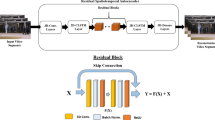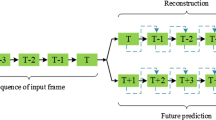Abstract
Video anomaly detection algorithms are yet to advance at the pace CCTV footage data of public places is being recorded and made publicly available. An anomaly specifies unusual activity or response in a video by one or more subjects/objects present in the video clip. Autoencoder being a powerful unsupervised method, has been popularly used for anomaly detection in various domains including video. In this work, we present a novel anomaly detection algorithm using deep autoencoders which exploits spatiotemporal features of training video clips along with a novel combined regularity score-based thresholding mechanism. Our model achieved AUC of 86.4% and 88.9% respectively over UCSD Peds1 and Avenue datasets successfully which is comparable with the existing works on video anomaly detection using autoencoders.







Similar content being viewed by others
References
Chong YS, Tay YH (2017) Abnormal event detection in videos using spatiotemporal autoencoder. In Advances in Neural Networks-ISNN 2017: 14th International Symposium, ISNN 2017, Sapporo, Hakodate, and Muroran, Hokkaido, Japan, June 21–26, 2017, Proceedings, Part II 14. Springer International Publishing. pp. 189–196
Liu T, Zhang C, Niu X, Wang L (2022) Spatio-temporal prediction and reconstruction network for video anomaly detection. PLoS ONE 17(5):e0265564
Gong D, Liu L, Le V, Saha B, Mansour MR, Venkatesh S, Hengel AVD (2019) Memorizing normality to detect anomaly: Memory-augmented deep autoencoder for unsupervised anomaly detection. In Proceedings of the IEEE/CVF International Conference on Computer Vision. pp. 1705–1714
Ullah W, Hussain T, Ullah FUM, Lee MY, Baik SW (2023) TransCNN: hybrid CNN and transformer mechanism for surveillance anomaly detection. Eng Appl Artif Intell 123:106173
Lee J, Nam WJ, Lee SW (2022) Multi-contextual predictions with vision transformer for video anomaly detection. In 2022 26th International Conference on Pattern Recognition (ICPR) (pp. 1012-1018). IEEE
Deshpande K, Punn NS, Sonbhadra SK, Agarwal S (2022) Anomaly detection in surveillance videos using transformer based attention model. In International Conference on Neural Information Processing (pp. 199–211). Singapore: Springer Nature Singapore
Hu X, Lian J, Zhang D, Gao X, Jiang L, Chen W (2022) Video anomaly detection based on 3D convolutional auto-encoder. SIViP 16(7):1885–1893
Duman E, Erdem OA (2019) Anomaly detection in videos using optical flow and convolutional autoencoder. IEEE Access 7:183914–183923
Chang Y, Tu Z, Xie W, Yuan J (2020) Clustering driven deep autoencoder for video anomaly detection. In Computer Vision–ECCV 2020: 16th European Conference, Glasgow, UK, August 23–28, 2020, Proceedings, Part XV 16 (pp. 329–345). Springer International Publishing, 2020. [CrossRef] [Google Scholar] [Publisher link]
Sabokrou M, Fathy M, Hoseini M (2016) Video anomaly detection and localisation based on the sparsity and reconstruction error of auto-encoder. Electron Lett 52(13):1122–1124
Deepak K, Chandrakala S, Mohan CK (2021) Residual spatiotemporal autoencoder for unsupervised video anomaly detection. SIViP 15(1):215–222
Le VT, Kim YG (2023) Attention-based residual autoencoder for video anomaly detection. Appl Intell 53(3):3240–3254
Fan Y, Wen G, Li D, Qiu S, Levine MD, Xiao F (2020) Video anomaly detection and localization via gaussian mixture fully convolutional variational autoencoder. Comput Vis Image Underst 195:102920
Liu Y, Liu J, Lin J, Zhao M, Song L (2022) Appearance-motion united auto-encoder framework for video anomaly detection. IEEE Trans Circuits Syst II Express Briefs 69(5):2498–2502
Li N, Chang F, Liu C (2020) Spatial-temporal cascade autoencoder for video anomaly detection in crowded scenes. IEEE Trans Multimedia 23:203–215
Li N, Chang F (2019) Video anomaly detection and localization via multivariate gaussian fully convolution adversarial autoencoder. Neurocomputing 369:92–105
Shin W, Bu SJ, Cho SB (2020) 3D-convolutional neural network with generative adversarial network and autoencoder for robust anomaly detection in video surveillance. Int J Neural Syst 30(06):2050034
Mishra S, Jabin S (2021) Recent trends in pedestrian detection for robotic vision using deep learning techniques. Artificial intelligence for future generation robotics. Elsevier, pp 137–157
Mishra S, Jabin S (2023) Real-Time pedestrian detection using YOLO. In: 2023 international conference on recent advances in electrical, electronics & digital healthcare technologies (REEDCON), New Delhi, India, pp 84–88. https://doi.org/10.1109/REEDCON57544.2023.10151150.
Mahadevan V, LiW, Bhalodia V, Vasconcelos N (2010) Anomaly detection in crowded scenes. In: 2010 IEEE computer society conference on computer vision and pattern recognition, IEEE, pp 1975–1981
Lu C, Shi J, Jia J (2013) Abnormal event detection at 150 fps in matlab. In: Proceedings of the IEEE international conference on computer vision, pp 2720–2727
Sarv Ahrabi S, Piazzo L, Momenzadeh A et al (2022) Exploiting probability density function of deep convolutional autoencoders’ latent space for reliable COVID-19 detection on CT scans. J Supercomput 78:12024–12045. https://doi.org/10.1007/s11227-022-04349-y
Bn Hasan M, Choi J, Neumann J, Roy-Chowdhury AK, Davis LS (2016) Learning temporal regularity in video sequences. In: 2016 IEEE Conference on Computer Vision and Pattern Recognition (CVP) pp. 733–742
Verma KK, Singh BM, Dixit A (2022) A review of supervised and unsupervised machine learning techniques for suspicious behavior recognition in intelligent surveillance system. Int J Inf Tecnol 14:397–410. https://doi.org/10.1007/s41870-019-00364-0
Anandhalli M, Tanuja A, Baligar VP et al (2022) Indian pothole detection based on CNN and anchor-based deep learning method. Int J Inf Tecnol 14:3343–3353. https://doi.org/10.1007/s41870-022-00881-5
Rani G, Pandey U, Wagde AA et al (2023) A deep reinforcement learning technique for bug detection in video games. Int J Inf Tecnol 15:355–367. https://doi.org/10.1007/s41870-022-01047-z
Chaurasia RK, Jaiswal UC (2023) Spatio-temporal based video anomaly detection using deep neural networks. Int J Inf Tecnol 15:1569–1581. https://doi.org/10.1007/s41870-023-01193-y
Kashika PH, Venkatapur RB (2022) Automatic tracking of objects using improvised Yolov3 algorithm and alarm human activities in case of anomalies. Int J Inf Tecnol 14:2885–2891. https://doi.org/10.1007/s41870-022-01062-0
Niu W, Long J, Han D, Wang YF (2004) Human activity detection and recognition for video surveillance. In: 2004 IEEE international conference on multimedia and expo (ICME) (IEEE Cat. No. 04TH8763), vol 1. IEEE, pp 719–722. https://doi.org/10.1109/ICME.2004.1394293
Author information
Authors and Affiliations
Corresponding author
Ethics declarations
Conflict of interest
The authors declare that there is no conflict of interest regarding the publication of this paper.
Rights and permissions
Springer Nature or its licensor (e.g. a society or other partner) holds exclusive rights to this article under a publishing agreement with the author(s) or other rightsholder(s); author self-archiving of the accepted manuscript version of this article is solely governed by the terms of such publishing agreement and applicable law.
About this article
Cite this article
Mishra, S., Jabin, S. Anomaly detection in surveillance videos using deep autoencoder. Int. j. inf. tecnol. 16, 1111–1122 (2024). https://doi.org/10.1007/s41870-023-01659-z
Received:
Accepted:
Published:
Issue Date:
DOI: https://doi.org/10.1007/s41870-023-01659-z




